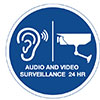
Why Audio? Why Not?
Focus on security now being shared with audio applications
- By Richard Brent
- Mar 01, 2014
It’s 2014 and time for a new way of thinking when it comes to security. It’s
kind of like our five senses; we have each one for a reason, and they are all
equally valuable. We need to start giving audio the same amount of attention
that we give video when it relates to security. Both audio and video should be
on the same playing field, but the present reality is that our industry remains
focused on video only systems.
While video surveillance has long been viewed as the primary technology in
a system, the time has come to recognize audio monitoring as an equally critical
component. In today’s security landscape where tragic events regularly make headlines,
it is imperative that both video and audio reign as kings of the security world
to further enhance safety. So, why audio? The answer is compelling.
Imagine walking into your office wearing noise-canceling earphones. You take
a detailed look around. Everything appears to be okay, so you sit down to work.
However, in this hypothetical scenario, there is someone shouting for help outside
your window. Had you been able to hear their cries for help then you may have
called for immediate assistance. The reality is that using video without audio is
like living in a silent movie. Let’s examine a real-life event where audio performed
where video alone couldn’t.
June 2012, Greece, New York, Karen Klein harassed on a school
bus: four schoolboys verbally abused this 68-year-old bus
monitor with violent and graphic threats. While the bus’
video surveillance captured footage of the boys pointing at
her it wa s the audio footage recorded and later posted to
YouTube that provided the most potent evidence—the boys’
voices lashing out at her. Ultimately, the boys were punished
with fines and suspension because of this evidence .
And that’s not all audio is capable of. In fact, there have been many recent strides
toward innovative technology in the audio monitoring field. For example, using a
network-based two-way audio system along with video, security staff can remotely
interact with suspicious persons in real time, rather than needing to physically send
a guard to the area. Instead, guards can monitor multiple zones, restricted areas or
commercial locations, better identify threats in progress, and quickly respond with
verbal warnings and directions. With so many security capabilities, why does audio
remain behind video when it comes to surveillance?
According to a recent report from research firm Memoori Business Intelligence
titled The Physical Security Business 2013 to 2017, the global market for security
products was expected to total $23.4 billion at the end of 2013 with video surveillance
representing 52 percent of this number, bringing in $12.26 billion. As if those
weren’t already impressive numbers, what’s more is that research firm, IHS, expects the global demand for video surveillance
to grow by more than 12 percent compared
to 2013. In taking a look at audio,
IHS reported that in 2013 more than
70 percent of network cameras shipped
globally had either unidirectional or
multidirectional audio capability; however,
these functions are estimated to be
used less than 10 percent of the time.
It is vital for security professionals
to recognize that they are limiting themselves
with using video only—audio
needs to be part of the overall security
plan. One of the key benefits of audio
monitoring is the fact that they are
compatible with a wide range of other
security devices, including cameras, recorders
and software. Specifically, audio
serves the security needs of a wide range
of organizations including: law enforcement,
education, quick service restaurants,
convenience stores, healthcare
providers, warehouse facilities, utilities
and infrastructure and retail industries.
When it comes to security, audio is
critical. There are many ways to use audio,
such as monitoring high traffic areas
to help keep people safe, equipping
businesses with audio security to help
them alleviate loss-prevention, providing
employee training, conducting dayto-
day business and much more. For example,
a local fast-food chain may want
to use audio monitoring to ensure that
employees are making orders correctly
and/or to ensure they are not stealing
resources from the organization.
In addition, a key benefit of audio
monitoring is that it helps to combat
false alarms and provides a secondary
verification in the case of an emergency,
robbery, security threat or other intrusion
by allowing companies to both see
and hear what is going on, when combined
with video security technology.
With audio monitoring, alarms can
be activated based on audio sounds—
sounds above a specified, adjustable
decibel level—captured by audio monitoring
products.
For example, in November 2013,
police in Evansville, Ind. received a
verified audio alarm at a local body
shop. When they arrived, two suspects
were taken into custody and each had
property from the body shop on them.
What’s great about a verified alarm is
that it provides real-time confirmation
of an intrusion via visual or audio monitoring
and notifies of an unauthorized
entry or attempted unauthorized entry.
This technology truly provides companies
and businesses with the reassurance
they need to keep their assets safe.
It is just a matter of time before more
major corporations start tapping the
power of audio for their security needs.
With that being said, let us make audio a
more integral part of the overall security
discussion now and not delay the inevitable.
Let us not fall behind as industry
leaders but instead start initiating these
conversations. We can no longer afford
to turn a deaf ear towards audio when
it comes to delivering a complete, allaround
security solution.
This article originally appeared in the March 2014 issue of Security Today.